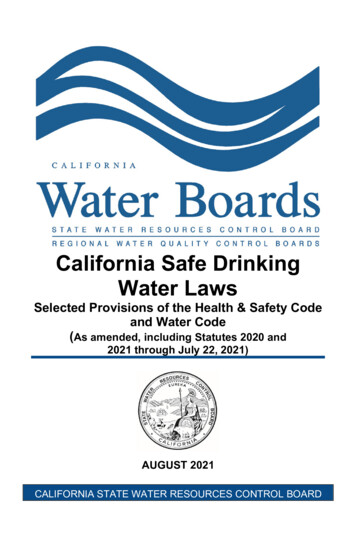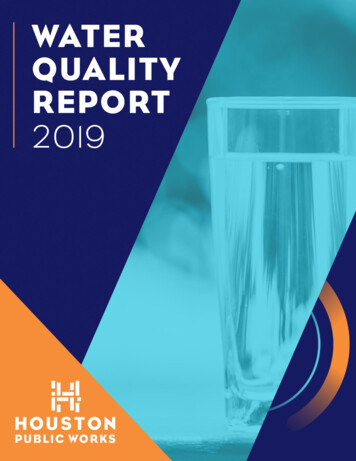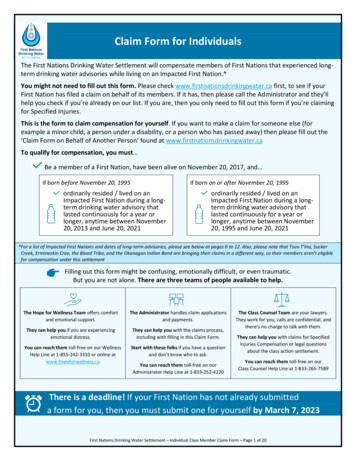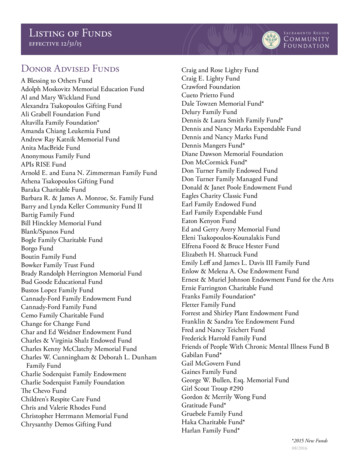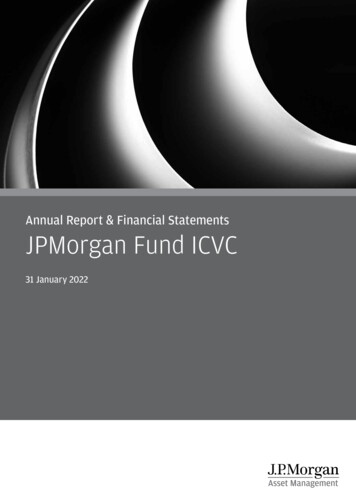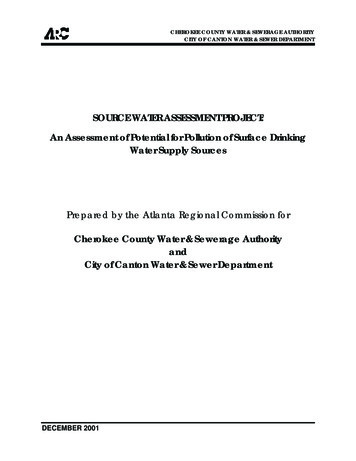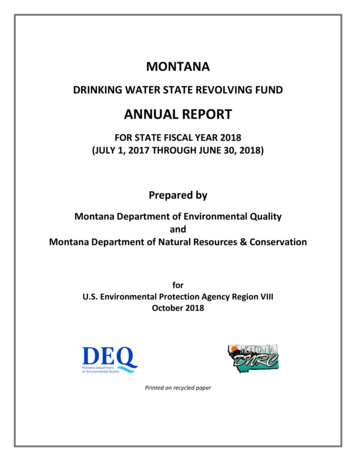
Transcription
MONTANADRINKING WATER STATE REVOLVING FUNDANNUAL REPORTFOR STATE FISCAL YEAR 2018(JULY 1, 2017 THROUGH JUNE 30, 2018)Prepared byMontana Department of Environmental QualityandMontana Department of Natural Resources & ConservationforU.S. Environmental Protection Agency Region VIIIOctober 2018Printed on recycled paper
This page intentionally left blank
SFY 2018 Annual Report for EPA – Drinking WaterTABLE OF CONTENTSI. INTRODUCTION . 1II. EXECUTIVE SUMMARY SFY18. 1III. GOALS OF THE DWSRF . 2Long-Term Goals . 2Short-Term Goals . 3IV. FINANCIAL REPORTS . 5V. DETAILS OF Drinking Water State Revolving Fund (DWSRF) ACTIVITY . 5A. Loan Assistance. 5Project Bypass . 5Disadvantaged Communities . 7Small Systems. 7Summary of Loan Assistance . 8B. First-Round Funded Loans . 8C. Recycled Funded Loans . 8D. Source of Funds . 8SFY18 . 9E. Federal Funds Drawn by the Drinking Water State Revolving Fund (DWSRF) Program . 9F. Set-Asides . 9Drinking Water State Revolving Fund (DWSRF) Administration . 9Small Systems Technical Assistance. 10Public Water Supply Supervision (PWSS) Set-Aside: Administration . 10Public Water Supply Supervision (PWSS) Source Water Protection (SWP) . 11Capacity Development . 12Public Water Supply Supervision (PWSS) Operator Certification . 13Local Assistance and Other State Programs - Source Water Delineation and Assessment andWellhead Protection . 13VI. GRANT CONDITIONS AND CERTIFICATIONS. 14VII. CURRENT STATUS AND FUTURE ACTIVITIES . 16VIII. GLOSSARY OF ACRONYMS AND INITIALIZATIONS . 18October 01, 2018Finali
SFY 2018 Annual Report for EPA – Drinking WaterTABLESTable 1. Population Served by Drinking Water State Revolving Fund (DWSRF) Loans in SFY18 . 8Table 2. Drinking Water State Revolving Fund (DWSRF) Loan Program Schedule for SFY19 . 17EXHIBITSExhibit 1: Sources of Drinking Water State Revolving (DWSRF) Funds through SFY 18 . 19Exhibit 2: DWSRF Capitalized Grant Closed Loans for SFY 18 . 22Exhibit 3: DWSRF Recycled Closed Loans for SFY 18 . Error! Bookmark not defined.Exhibit 4: DWSRF Projected Loan Agreements SFY 19 . 23Exhibit 5: Amounts available to Transfer between SRF Programs. 24Exhibit 5A: Transfer of Funds Between SRF and WRF . 25Exhibit 6: Summary of Drinking Water State Revolving Fund (DWSRF) Federal Draws for SFY 18 . 27Exhibit 7: Drinking Water State Revolving Fund: State Fiscal Year 2018 Budget vs Draw Category . 32Exhibit 8: DWSRF Loans – MBE/WBE for Contracts Awarded During SFY 18 . 44APPENDICESAPPENDIX A: SFY18 Cash Flow Model. 45APPENDIX B: Financial Statements Unaudited With Footnotes . 49APPENDIX C: SFY18 Intended Use Plan . 50APPENDIX D: Map of Projects and List . 51October 01, 2018Finalii
SFY 2018 Annual Report for EPA – Drinking WaterI. INTRODUCTIONThis annual report adheres to the Operating Agreement negotiated between the State of Montana andthe Environmental Protection Agency (EPA) concerning the administration of the Drinking Water StateRevolving Fund (DWSRF). The annual report summarizes DWSRF activities for the state fiscal periodbeginning July 1, 2017, and ending June 30, 2018 (State Fiscal Year (SFY) 2018).The DWSRF program was established as a result of the 1996 Amendments to the Federal Safe DrinkingWater Act (SDWA), which provided the authority for EPA to make capitalization grants to states. Thegrants, in conjunction with state matching funds, are used to provide financial assistance for theconstruction of drinking water projects and support administration of the state program.In anticipation of the 1996 Amendments to the Federal SDWA, the 1995 State Legislature, under Title75, Chapter 6, Part 2, Montana Code Annotated, passed the enabling legislation, entitled the SafeDrinking Water Treatment Revolving Fund Act, giving authority to the Montana Department ofEnvironmental Quality (DEQ) and Montana Department of Natural Resources & Conservation (DNRC) toadopt administrative rules to implement the program. Legislation also provided the ability to generatestate matching funds through the sale of state General Obligation Bonds (GO Bond Authority).Amendments to the Drinking Water State Revolving Fund Act were passed in the 1997, 1999, 2001,2003, and 2005 Legislative Sessions. The 1997 amendments changed the title of the Act from “SafeDrinking Water Treatment Revolving Fund Act” to “Drinking Water State Revolving Fund Act” and alsomade other changes consistent with the Federal Act. During the 1999 Legislative Session, the 1999amendment clarified the transfer language between the DWSRF and Water Pollution Control StateRevolving Fund (WPCSRF) programs and added GO Bond Authority. The 2001 amendment authorizedthe program to advance funds to projects funded, in part, by the federal government when federalfunding was approved but not appropriated. This provides interim financing until those federal fundsbecome available. The 2003 amendment increased GO Bonding Authority by 10 million, raising thetotal to 30 million. The 2005 amendment authorized the issuing of Revenue or Grant AnticipationNotes (GAN) as well as authorized limited principal forgiveness to disadvantaged communities.II. EXECUTIVE SUMMARY SFY18During SFY18 Montana applied for the Federal Fiscal Year (FFY) 18 capitalization grant. This grant wasawarded July 24, 2018.Since the inception of the DWSRF, Montana has issued six GO Bonds, five Bond Anticipation Notes(BAN), and four Revenue Anticipation Notes (RAN). These proceeds have been used as state match forloans, set asides, and program administration. Montana issued its first GO Bond in October 1998(SFY99), its second GO Bond in April 2000 (SFY00), its third GO Bond in June 2001 (SFY01), its fourth GOBond in June 2003 (SFY03), its fifth GO Bond in May 2005 (SFY05), and its sixth GO Bond in May 2010(SFY10). The total amount of bonds, BANs, and RANs issued to date is 33,395,000, with other statefunds generated, match is 42,896,668. A summary of these bond issues is provided in Exhibit 1.(Montana is planning for its sixth BAN late in calendar year 2018.)Exhibit 1, Sources of DWSRF Funds through SFY18, provides a complete tabulation of capitalization grantawards received through June 30, 2018; projected state match; binding commitments for loan projectsOctober 01, 2018Final1
SFY 2018 Annual Report for EPA – Drinking Waterthrough SFY18; and GO Bonds, BANs, and RANs, and other state match issued for total state match. Thecombination of capitalization grants and bond proceeds provided the needed funds for DWSRF projects,set asides, and program administration during SFY18. In addition, DNRC provided a portion of theirprogram administration services as an in-kind contribution in the amount of -0- for SFY18.During SFY18, the DWSRF program executed 22 project loan agreements totaling 26,778,203, (notincluding Bond Anticipation Notes –BAN). For a detailed breakdown of all DWSRF loan agreementssigned and key dates of project activity that occurred in SFY18, refer to Exhibit 2: DWSRF CapitalizedGrant Closed Loans for SFY18, and Exhibit 3: DWSRF Recycled Closed Loans for SFY18.Detailed information concerning use of DWSRF funds, accomplishments of the program, and adherencewith the stated goals of the program is provided on the following pages.III. GOALS OF THE DWSRFThe following sections describe the goals of the DWSRF program as identified in the SFY18 Intended UsePlan (IUP) and discuss how these goals were achieved through the activities performed by DNRC andDEQ personnel throughout the course of SFY18.LONG-TERM GOALS1. To continue building and maintaining a permanent, self-sustaining SRF program that will serve as acost-effective, convenient source of financing for drinking water projects in Montana.Projects funded during SFY18 met all program requirements governing financial capability to assumedebt. Twelve of 21 loans received an interest rate of 2.50% on their loans (well below market rates),and 6 of the 21 received principal forgiveness. In addition, three projects received an interest rate of2.50% under the refinancing criteria, and one community received an interim loan at 1.25% to payfor engineering. These factors illustrate that the assistance is affordable. Refer to Exhibits 2 and 3. Acopy of the cash flow with all the activity through SFY18 is included in this report as Appendix A.2. To provide a financing and technical assistance (TA) program to help public water supplies achieveand maintain compliance with federal and state drinking water laws and standards for theprotection and enhancement of Montana’s public drinking water.To promote the availability of these DWSRF program services during SFY18, DWSRF staff presentedinformation at a variety of events. This included an infrastructure workshop at the annual MontanaRural Water Systems Conference in Great Falls, and one-on-one meetings with community leaders.Please also refer to the project descriptions and discussion of set-asides provided in Section V:Details of DWSRF Activity.October 01, 2018Final2
SFY 2018 Annual Report for EPA – Drinking WaterSHORT-TERM GOALS1. To continue implementation and maintain the DWSRF program in Montana.Since the approval of its DWSRF loan program and first capitalization grant award, Montana hasbeen awarded 20 more capitalization grants; issued matching GO Bonds, BANs, and RANs; utilizedthe provision to transfer funds between the WPCSRF and DWSRF; and generated other revenuefrom loan repayments and interest investments. The amount of closed loans through June 30, 2018,now totals 320,105,918. Please see Appendix D project list and location map.2. To fund projects that address specific and immediate requirements of the SDWA, including theDisinfectant/Disinfection Byproducts (DBP), Long Term 2 Enhanced Surface Water Treatment, andArsenic Rules, Montana anticipated funding at least nine projects to address water treatment inSFY18.The anticipated projects for water treatment listed in the SFY18 IUP were for the Town of Denton,City of Ronan, City of Big Timber, Yellowstone Boys & Girls Ranch WSD, the Town of Whitehall, theTown of Flaxville, the City of Laurel, Glendive, and the City of Great Falls. Ronan Denton, and GreatFalls closed loans and their projects are at various stages of design or construction. The otherprojects listed above are expected to close a loan in SFY19.3. To fund projects that promote regionalization and/or achieve consolidation of two or more existingpublic water supplies, thereby improving water quality. Montana expected to fund five consolidationprojects in SFY18.Three consolidation project loans were closed during SFY18 for the Upper/Lower River Road WSD(Great Falls), the Dry Redwater Regional System, and the Town of Froid (in conjunction withconnecting to the Dry Redwater Regional System). The Dry Prairie Regional Water System isexpected to close additional DWSRF loans later in SFY19.4. To fund projects that address replacement of aging infrastructure. Montana anticipated funding atleast 8 projects of this type in SFY18.Six new projects (8 loans) were funded in SFY18 to replace aging infrastructure. These projects werethe Ramsay WSD, the City of Three Forks, the Town of Fromberg, the City of Conrad, the LockwoodWSD, and the City of Malta. They totaled 3,753,100 and were funded from the 2015 and 2016grants, along with bond proceeds, and recycled funds.5. To fund projects that develop system sustainability through financial capacity by refinancing existingdebt. One refinancing loan was expected in SFY18.Three loans were closed in SFY18 to refinance debt previously incurred. In addition, several loansare anticipated in SFY19 for this purpose.6. To ensure the technical integrity of DWSRF projects through the review of planning, design plans andspecifications, and construction activities.October 01, 2018Final3
SFY 2018 Annual Report for EPA – Drinking WaterDEQ’s trained technical staff continues to use the DWSRF Handbook of Procedures and knowledgegained from many years of operating both SRF programs to ensure that this objective is met. TheHandbook of Procedures is used as a guide to ensure that all state and federal laws governing thetechnical aspects of each project are satisfied. Steps were taken to update the Handbook ofProcedures and streamline checklists and processes. A final revised edition was submitted to EPA inSeptember 2001. This effort was completed in early SFY02. It was again reviewed and updatedduring SFY06, with some minor revisions made in 2007 and 2008. Another review was completed inSFY16. It was crosschecked with the WPCSRF handbook for consistency, and was submitted to EPAlater in SFY17.Staff attend training seminars and workshops to maintain and improve technical, financial, andprogrammatic knowledge. In SFY18 Anna Miller, Bill Herbolich, and Mark Smith, attended theCouncil of Infrastructure Financing Authorities (CIFA) National Workshop; Anna Miller, Diana Hoy,Robert Ashton, Marc Golz, and Mark Smith attended the Montana Rural Water Systems Conference;Gary Wiens, Robert Ashton, Marc Golz, and Mark Smith attended Montana’s American Water WorksAssociation (AWWA) Conference; and Anna Miller and Mark Smith attended the CIFA LegislativeConference.7. To provide outreach to communities and utilize the set-aside funding by:a. providing TA to water suppliers who request help with their system operation andmaintenance (O&M) proceduresb. providing financial and managerial assistance as part of capacity development education tothose water supplies who request this type of helpc. assisting communities with the next phase of implementation of their SourceWater/Wellhead Protection Plansd. emphasizing that Public Water Supply Program (PWSP) staff perform sanitary surveys;facilitate SDWA compliance of the Long Term 2 Enhanced Surface Water Treatment, Stage 2Disinfectant/Disinfection By-Products, Groundwater, and Arsenic Rulese. ensuring that 95% or more of the state’s community and non-transient non-communitywater systems continue to have certified operatorsPlease see discussion of individual set-aside activities and accomplishments in Section V: Details ofDWSRF Activity (F: Set-Asides).8. To ensure the financial integrity of the DWSRF program through the review of the financial impactsof the set-asides and disadvantaged subsidies and individual loan applications and the ability forrepayment.See Appendix A: Cash Flow Model SFY18.October 01, 2018Final4
SFY 2018 Annual Report for EPA – Drinking Water9. To ensure compliance with all pertinent federal, state, and local safe drinking water rules andregulations.To the best of our knowledge, the DWSRF program has ensured Public Water Supply Supervision(PWSS) compliance through the projects that have been funded and the various set-aside activities.Close coordination with the PWSS program has been essential in this effort.IV. FINANCIAL REPORTSThe Montana Legislative Audit Division (LAD) has completed their audit work for SFY17. Financialstatements were presented to the Legislative Audit Committee (LAC). A qualified opinion was issued forthe financial statements. A copy of the report was submitted to EPA Region VIII.DEQ and DNRC engaged LAD to audit SRF financial activity beginning in SFY98. This decision was basedon a new audit requirement conveyed in a directive from the Office of Water, Inspector General’s Office,and the Office of Management and Budget.The SFY18 unaudited financial statements for DWSRF, including footnotes, are included as Appendix B.The SFY18 audit should be complete by May 2019.V. DETAILS OF DRINKING WATER STATE REVOLVING FUND(DWSRF) ACTIVITYA. LOAN ASSISTANCEIt should be noted that for reporting purposes, beginning in SFY11, binding commitment dates andamounts are now identical to loan closing dates and amounts in an effort to simplify the reportingprocess.During SFY18 the DWSRF program closed 22 loans. Eighteen new loans initiated construction, and 10projects were completed. The rate of construction with respect to fund disbursements at fiscal year-endwas approximately 96.4% ( 308.5 million in disbursements and 320.2 million in loans). The overall fundutilization rate is approximately 88.4%( 320.2 million in loans; 362.3 million in available funds. Re.EPA).Project BypassIf it is determined by DEQ that a project or projects are not ready to proceed or that the projectsponsors have chosen not to use the DWSRF funds, other projects may be funded in an order differentfrom that indicated on the priority list. If DEQ chooses to bypass higher-ranked projects, it should followthe bypass procedure.Montana bypassed 104 projects on its priority list with the funding of the City of Three Forks loan,ranked 116. Eleven other communities (20 loans) closed loans. The higher-ranked projects were notready to proceed at the time, or perhaps were being financed by other funding entities. They werebypassed to fund lower-ranked projects that were ready to proceed with construction or that hadOctober 01, 2018Final5
SFY 2018 Annual Report for EPA – Drinking Wateralready been constructed and desired refinancing to improve financial capacity. Refer to Exhibit 2:DWSRF Capitalized Grant Closed Loans for SFY18, and Exhibit 3: DWSRF Recycled Closed Loans forSFY18. Notification of bypass describing proposed projects to be funded and assurance of availablefunds for all anticipated loan applications was sent to bypassed communities. No responses werereceived. No emergency projects were funded in SFY18. The status of top-ranking individual projects onthe priority list that were bypassed is discussed below.1. Town of Denton. The system has negotiated a compliance schedule with DEQ, which includedapplying for other state grant funding in 2017. An application to RD has been submitted. A SRF loanwas closed SFY18 for engineering services.2. Crow Tribe. The system has obtained alternative federal grant funding sources for source watertreatment. SRF Funding may still be desirable for distribution improvements, but that project willneed to be re-ranked on the priority list and needs to be removed.3. Carter-Choteau Co. WSD. An SRF loan was closed in SFY13 and a water treatment project wascompleted. The WSD has also completed phase 2 of the project which consists of booster pumpstation improvements in SFY16. This project was inadvertently left on the priority list and needs tobe removed.4. Eureka. Construction of a new membrane filtration plant is complete. The plant is on-line, treatingwater, and in the first-year performance warrant period.5. City of Ronan. An SRF loan to construct a treatment plant building addition and to install filtrationequipment was closed in SFY17. Construction is under way and nearing substantial completion.6. Eureka. This is an inadvertent duplicate of project No. 4 above and needs to be removed from thepriority list.7. South Winds WSD. An SRF loan to construct a water system improvements project was closed inSFY16, and construction was completed in SFY17. The next phase, consisting of water (and sewer)main replacement, is scheduled to begin in Late SFY 2019.8. Upper/Lower River Road WSD. Phase V improvements of this project closed a Bond AnticipationNote early in SFY17, and construction was completed. Long term SRF loan was closed early in SFY18,and the project can now be removed from the priority list.9. Big Timber. Construction of a new membrane filtration plant started in June 2018. Completion isexpected in 2019.10. Town of Pinesdale. An SRF loan was closed in SFY17 and construction on a water treatment plant iscomplete. Performance certification has been received and the project has been closed out. It canbe removed from the priority list.11. & 13. Town of Neihart. A preliminary engineering report (PER) has been submitted for the projectand the system is pursuing other grant funding. An SRF loan application may be submitted in thefuture, but the exact status of the project is unknown.October 01, 2018Final6
SFY 2018 Annual Report for EPA – Drinking Water12. Yellowstone Boys and Girls Ranch WSD. Engineering plans and specifications for this project wasapproved by DEQ, and an SRF loan was closed in SFY17. Construction is nearly complete.13. See # 11.14. Whitehall. A PER has been submitted and the town is pursuing grant funds for the project. An SRFLoan Application is expected in 2019.15. Town of Flaxville. The town has been working with DEQ to resolve the system’s nitrate problemsthrough streamlining existing treatment processes. An SRF loan for additional treatment equipmentmay still be needed in the future.16. Town of Philipsburg. An SRF loan was closed in SFY15 and construction of a treatment building, andUV disinfection system has been completed. This project can be removed from the priority list.17. Dry-Redwater Regional Water Authority. Construction has begun on an extensive distributionsystem using an interim water supply. An SRF Loan was closed in SFY 2018. An additional loan tofund subsequent phases is expected to close in 2019.18. Rocky Boys/North Central Regional Water System. Design is almost completed on the next phase ofthis project. Other sources of funding, along with an SRF are expected to close in SFY19.19. City of Laurel. Treatment plant improvements including a new intake, have completed construction.An SRF Loan was closed in SFY17. An additional SRF Loan for the next phase of improvements isanticipated in SFY19.20. Central Montana Regional Water Authority. The authority is awaiting federal authorization and thenwill proceed with trying to obtain federal funding. An SRF loan is also anticipated in the future toprovide additional funding.Disadvantaged CommunitiesCommunities seeking a DWSRF loan that meet the disadvantaged community criteria described in theIUP may receive an additional subsidy on their SRF loans beyond the standard below-market ratefinancing. This includes communities that will meet the disadvantaged criteria based on projected ratesas a result of the project.In SFY18 Montana closed 14 loans with 8 communities meeting the disadvantaged criteria. Some of theloans had a 2.50% interest rate. Some loans were forgiven. One of the loans had an extended term ofmore than 20 years. The closed loans for disadvantaged communities totaled 4,436,175 and some had50%, or up to a maximum of 500,000, in principal forgiveness for 1,550,550. In SFY19, we will haveseveral loans with communities that may qualify for disadvantaged assistance.Small SystemsTable 1 shows the breakdown of the population served by DWSRF loans in SFY18. We had 22 loans with13 communities for a total of 26,778,203601,7. Twelve communities (20 loans) are small systems thatserve a population of less than 10,000 people. Small systems represent 31% of the loans we made inSFY18.October 01, 2018Final7
SFY 2018 Annual Report for EPA – Drinking WaterTable 1. Population Served by Drinking Water State Revolving Fund (DWSRF) Loans in SFY18Public Water SupplyPopulation250025002900Loan Amount 500,000 897,000 866,312Denton EngineeringDry Redwater RegionalFroid BFroid CFromberg AFromberg B201152185185438438 182,000 75,000 174,000 174,000 171,800 171,800Fromberg C RefinanceLockwoodMalta DRamsay A RefinanceRamsay BRamsay C43867972000979797 481,000 2,000,000 690,000 143,000 59,750 59,750Ronan ARonan BThree ForksUpper/Lower River Road WSDUpper/Lower River Road WSDTotal2100210019644141 500,000 650,000 100,000 145,000 143,075 8,183,487ConradConrad RefinanceCut Bank RefinanceSummary of Loan AssistanceIn SFY18, the DWSRF maintained steady performance by executing 22 project loan agreements for atotal of 26,778,203. We project in SFY19 that we will execute in excess of 33,300,000 in loanagreements. See Exhibit 4: DWSRF Projected Loan Agreements for SFY19.B. FIRST-ROUND FUNDED LOANSFirst-round loans are financed with capitalization grants and state match. The DWSRF has financed theprojects listed in Exhibit 2: DWSRF Capitalized Grant Closed Loans for SFY18.C. RECYCLED FUNDED LOANSRecycled loans are financed with loan repayments from first round money and funds from transfersfrom the WPCSRF program. The DWSRF has financed the projects listed in Exhibit 3: DWSRF RecycledClosed Loans for SFY18. There were three loans made that used recycled funds in SFY18.D. SOURCE OF FUNDSTwo sources of funds are used to capitalize the DWSRF: (1) the Federal Capitalization Grant, whichprovides 80% of the DWSRF loan funds, and (2) the state match, funded through the sale of GO Bonds,October 01, 2018Final8
SFY 2018 Annual Report for EPA – Drinking WaterRANs, and BANs which provides 20% of the DWSRF loan funds. State legislation originally authorized thesale of up to 10 million in GO Bonds to match federal grant funds. In the 1999 and 2003 LegislativeSessions, an additional 10 million of GO Bonds were authorized each time for state match, bringing thetotal authorized to 30 million. This amount is adequate to cover funds currently authorized for theprogram. GO Bonds, plus RANs and BANs, for a total of 42,896,668 have been issued by the DWSRFprogram to use as state matching funds through SFY17. See Exhibit 1: Sources of DWSRF Funds throughSFY18. In SFY18, in-kind services of 0 have been provided to the DWSRF program by DNRC as match tofederal grant funds and were used for program administration. Also, 11,282,486 of funds, have beentransferred from the WPCSRF to the DWSRF for loans to date. See Exhibits 5 and 5A for a history oftransferred funds between the two SRF programs.The State of Montana adds a Loan Loss Reserve and an Administrative surcharge to its interest rate. TheLoan Loss Reserve funds are used to fund the required reserve for the DWSRF program bonds issued.Amounts over that required reserve are transferred to the principal account to be used for loans or tothe debt service account to pay down the debt. The Administrative surcharge is used to fundadministrative program costs not covered by the capitalization grants.SFY18Loan Loss Reserve funds collected: 300,814Loan Loss Reserve funds transferred to Principal Account: 0Loan Loss Reserve funds transferred to Debt Service Account: 634,545Administrative funds collected: 818,284E. FEDERAL FUNDS DRAWN BY THE DRINKING WATER STATE REVOLVING FUND(DWSRF) PROGRAMExhibit 6, SFY1
debt. Twelve of 21 loans received an interest rate of 2.50% on their loans (well below market rates), and 6 of the 21 received principal forgiveness. In addition, three projects received an interest rate of 2.50% under the refinancing criteria, and one community received an interim loan at 1.25% to pay for engineering.

